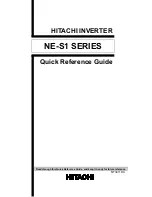
ENGLISH • 11
6. Ventilation Openings: The ventilation openings should
not be covered at any time while the inverter is operating.
OPERATING TIPS
The inverter should only be operated in locations that are:
a. Dry: Do not allow water or other liquids to come into
contact with the inverter.
b. Cool: Surrounding air temperature should ideally
be 32°F and 104°F (0°C and 40°C). Keep the inverter
away from direct sunlight, when possible.
c. Well-Ventilated: Keep the area surrounding the
inverter clear to ensure free air circulation around
the unit. Do not place items on or over the inverter
during operation. The unit will shut down if the internal
temperature gets too hot. The inverter will auto-reset
after it cools down.
d. Safe: Do not use the inverter near flammable
materials or in any locations that may accumulate
flammable fumes or gases. This is an electrical
appliance that can briefly spark when electrical
connections are made or broken.
Your 100W Power Inverter supplies maximum output
power is 100W continuous power. When you turn on an
appliance or a tool that operates using a motor or tubes, it
requires an initial surge of power to start up. This surge of
power is referred to as the “starting load” or “peak load”.
Once started, the tool or appliance requires less power to
continue to operate. This is referred to as the “continuous
load” in terms of power requirements.
You will need to determine how much power your tool or
appliance requires to start up and its continued running
power requirements.
Most often the start up load of the appliance or power tool
determines whether your inverter has the capability to power it.
Sample applications
Audio/Video
Video Game System
20 watts
Camcorder (6V, 1200mA) Battery Charger
20 watts
Sharp HiFi Stereo 4-Head VCR
40 watts
Kenwood CD Changer/Mini System
60 watts
Home Office
Cellular Telephone Battery Charger
25 watts
IBM Think Pad Laptop Computer
42 watts
Power Tools
Stanley Glue Gun
20 watts
Your 100W DC to AC Power Inverter should be connected
directly to your vehicle’s 12V cigarette or power outlet
socket. We recommend that the equipment or appliance
switch be in the “OFF” position prior to plugging into the
AC receptacle of the inverter. The green LED light will
confirm that AC power is present.
1. Place the cigarette lighter in the vehicle’s 12V
cigarette or power outlet socket
2. Plug in the AC product you want to operate
3. Disconnect the unit from the battery
when not in use for safety.
Caution! When short circuit occurs, the inverter
shuts off automatically to protect the inverter from
damage.
OPERATING THE INVERTER
1. After properly connecting the unit and the powered
equipment
2. Check the connections
3. Turn on the AC products
Caution! Connect the AC product one at a time.
Through its AC outlet, the inverter is capable of powering
most 220V products that use 100W or less. The unit will
operate from input voltages ranging from 11V to 15V DC.
As the battery is being used, its voltage begins to fall.
When the inverter senses that the voltage at its DC input
has dropped to the range of 9.7V ~ 10.3VDC, the unit will
automatically shut down and the red LED indicator will
light, indicating a fault.
This protects the battery from being over-discharged.
Turn off any devices that the inverter powers. When input
voltage rose to 11.7V ~ 12.3V, the inverter restores normal
Caution! Most vehicle batteries are designed to provide
short period of very high current for starting the engine.
They are not designed for a constant “deep discharge”.
Constantly operating the unit from a vehicle battery until
the low voltage shut off will affect the life of the battery.
If you are operating electrical products for extended periods
of time, you should consider connecting the unit to a separate
deep discharge battery.
Should a defective battery charging system cause
the battery voltage to rise to the range of 15V ~ 16VDC,
the inverter automatically shuts down; and the red LED lights.
Caution! Although the inverter incorporates
protection against over-voltage, it may still be
damaged if the input voltage exceeds 16V.
Summary of Contents for PI100LA
Page 2: ...FIG A 1 2 3 4 6 5 ...
































